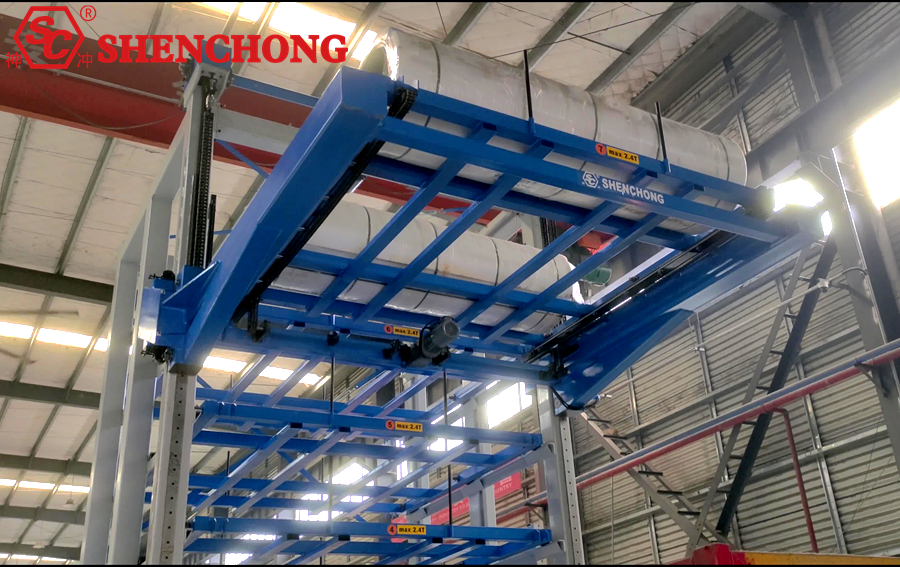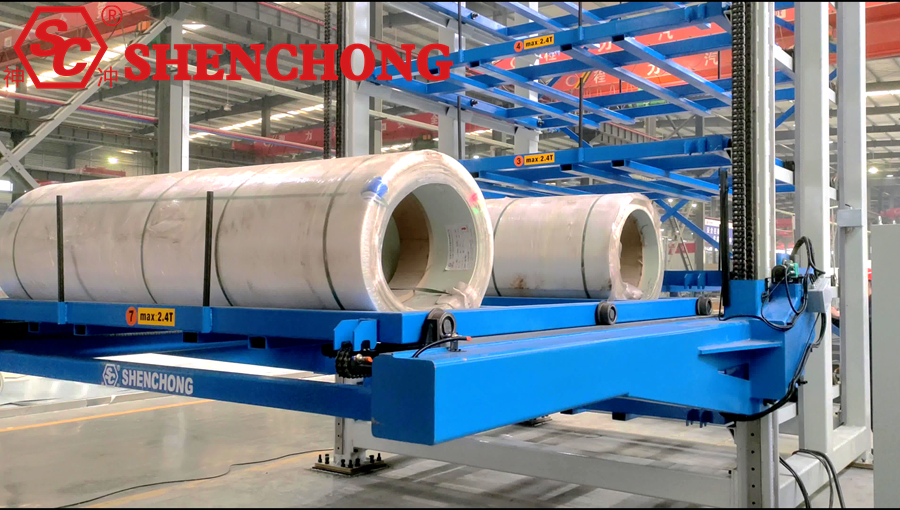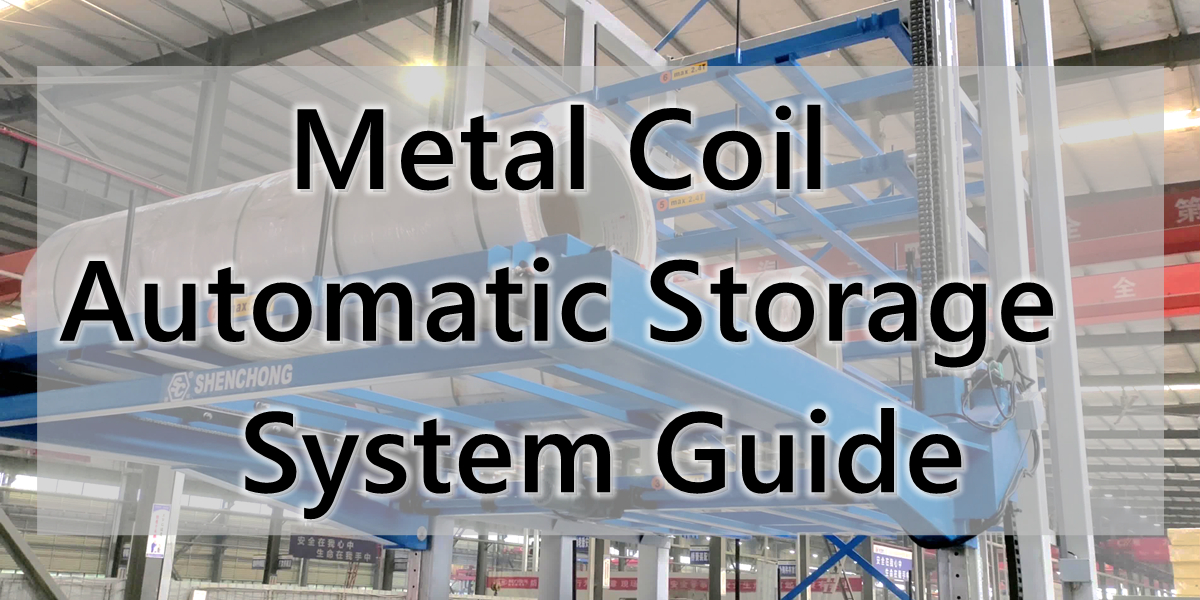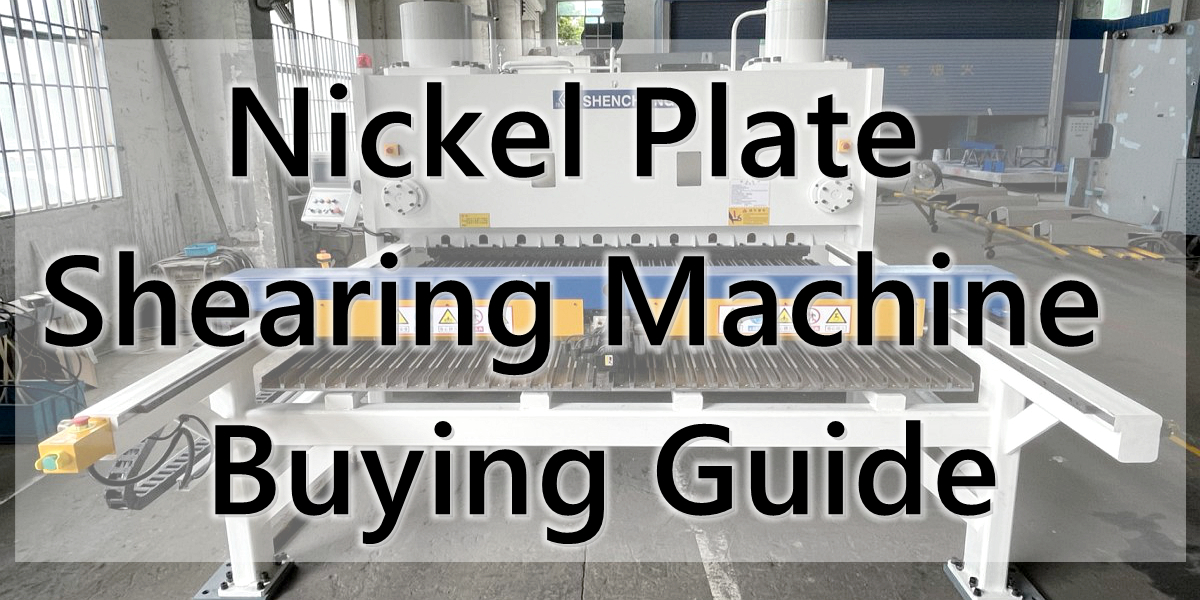Table of Contents
Metal coil automatic storage system is an intelligent storage and management system specifically designed for heavy metal coils such as steel coils, aluminum coils, copper coils, and stainless steel coils. This system integrates automatic storage and retrieval, information management, and intelligent scheduling, significantly improving coil storage security, space utilization, and production logistics efficiency.
1. System Overview Of Metal Coil Automatic Storage System
The Metal Coil Automated Storage and Retrieval System (Coil AS/RS) is an intelligent warehousing solution for the steel, aluminum, copper, and sheet metal manufacturing industries.
This system utilizes automated stacker cranes, overhead cranes, conveyor systems, and an intelligent scheduling system to achieve automated warehousing, location-based storage, intelligent outbound processing, and information management of metal coils, significantly improving factory space utilization, safety, and logistics efficiency.
1) Metal Coil Automated Storage System Main Functions
- Automatic Warehousing: The system automatically identifies coil information and allocates the optimal storage location.
- Automatic Outbound Processing: Automatically schedules and dispatches coils to designated workstations according to production instructions.
- Intelligent Inventory: Enables fast and accurate inventory counting through barcode/RFID technology.
- Batch Traceability: Completely records the entire lifecycle of coils from warehousing to use.
- Safety Protection: Equipped with fall protection, collision protection, weight detection, and temperature monitoring systems.

2) System Applications
- Steel Service Center
- Automotive Sheet Metal Processing Plant
- Aluminum/Copper Coil Processing Plant
- Sheet Metal Manufacturing and Home Appliance Manufacturing Enterprises
- Aerospace and Shipbuilding Material Storage Base
Typical Application Cases (Examples):
- A steel service center: Constructed an automated storage and retrieval system (AS/RS) for coils, reducing annual labor costs by 30% and increasing outbound efficiency by 60%.
- An aluminum sheet production line: Adopted a bridge crane + AGV system to achieve automatic raw material coil storage and intelligent material batching on the production line.
- A home appliance manufacturing plant: Seamless integration of the WMS system and MES system to achieve automated production scheduling and precise material delivery.
2. System Structure Composition
The entire system typically consists of four main parts: mechanical structure, conveying unit, control system, and information management system.
1) Automated Storage and Retrieval System
Utilizes a high-strength heavy-duty steel structure to meet the load-bearing requirements of single roll weights from 3 to 30 tons.
Support types are optional:
- V-type bracket type: Suitable for precise positioning of single rolls.
- Saddle type: Suitable for mixed storage of multiple roll specifications.
- Rack height, number of rows, and number of aisles can all be customized.
2) Automated Stacker Crane/Overhead Crane System
Achieves automated storage and retrieval of rolls within the automated storage and retrieval area.
Equipped with intelligent lifting devices, hydraulic clamps, or magnetic suction devices, automatically adapting to different roll diameters.
Positioning accuracy up to ±2 mm, operating speed up to 120 m/min.
Supports communication with the WMS system for automatic path planning and task scheduling.
3) Conveying System
Utilizes a combination of chain conveyors, roller conveyors, turntables, and lifting platforms.
Enables fully automated flow of roll materials between the production line and warehouse.
Optional AGV/RGV automated guided vehicles (AGVs) are available for flexible logistics.
4) Control and Management Systems
WCS (Warehouse Control System): Real-time control of equipment actions and task execution.
WMS (Warehouse Management System): Responsible for inventory, batch, location, and status management.
Supports seamless integration with ERP/MES systems for enterprise-level data interconnection.
Equipped with a visual user interface, providing 3D warehouse monitoring and statistical analysis.
3. Material Warehouse System Working Principle
1) Working Principle
Inbound Process:
Coil material comes off the production line → Conveyor line identifies roll number/weight → System allocates optimal storage location → Stacker crane/overhead crane automatically stores the material.
Storage Management:
The system intelligently categorizes and manages materials based on roll diameter, weight, material, customer orders, etc.
Supports dynamic layout optimization to improve space utilization.
Outbound Process:
Receives production instructions → System automatically schedules optimal path → Coil material is shipped out → Conveyed to designated processing line.
Information Traceability:
Each roll of material has a unique number, allowing the system to track the complete history from inbound to outbound.

2) Main Functional Modules
- Automatic Inbound: Automatic identification of roll material information, location optimization, and generation of inbound records.
- Automatic Outbound: Automatically outbound materials to designated workstations according to production plans.
- Intelligent Scheduling: Automatically plans storage and retrieval order based on task priority and path.
- Information Traceability: Full lifecycle data recording and traceable query.
- Intelligent Inventory Management: Automatically calculates inventory quantity, weight, and status.
- Safety Management: Features collision detection, fall protection, overload alarm, temperature and humidity monitoring, etc.
- Data Analysis: Visualized reports such as inventory reports, usage frequency analysis, and energy consumption statistics.
4. System Advantages of Automated Metal Coil Storage Systems
1) High Space Utilization
3D Structural Design: Multi-layered vertical storage racks maximize factory space utilization.
Optimized Layout Algorithm: The system automatically allocates optimal storage locations based on coil diameter and weight, increasing storage density.
40-70% Footprint Saving: Significantly increases storage capacity per unit area compared to traditional planar stacking methods.
2) High Operational Efficiency
Automated Inbound/Outbound Operations: Stacker cranes or overhead cranes operate fully automatically, requiring no manual intervention.
Rapid Response to Production Needs: Linked with production line information systems (MES/ERP), automatically retrieves designated coils.
Strong Continuous Operation Capability: Operates 24/7, significantly improving inbound/outbound efficiency.
3) High Safety
Unmanned Operation: Avoids manual hoisting and close-range handling, significantly reducing safety risks.
Multiple Safety Protections: Equipped with weight detection, fall protection, collision protection, and travel limit protection.
Equipment Monitoring System: Real-time monitoring of coil status, temperature, humidity, and equipment operation to prevent accidents.
4) High Level of Intelligence
WMS (Warehouse Management System) + WCS (Control System) Collaboration: Enables intelligent scheduling and visualized management.
Automatic Identification and Traceability: Supports barcode and RFID identification; each coil can be tracked throughout its entire lifecycle.
3D Visual Monitoring Interface: Real-time display of coil location, status, and inventory structure.
5) Strong Flexibility and Compatibility
Modular Structure Design: The system can be flexibly laid out according to the factory structure and supports phased expansion.
Compatible with Multiple Coil Types: Steel coils, aluminum coils, copper coils, stainless steel coils, etc., can all be stored.
Multi-Mode Handling Interface: Supports seamless integration with conveyor lines, AGV/RGVs, uncoiling lines, and slitting lines.
6) Information and Traceability Management
Data Integration: Can connect with ERP, MES, and SCADA systems to achieve data linkage between production and warehousing.
Batch Traceability: Records the entire process from warehousing to outbound, supporting rapid querying and quality traceability.
Report Analysis: Automatically generates statistical reports such as inventory, inbound/outbound data, and turnover rate, supporting decision-making optimization.
7) Reduced Costs and Energy Consumption
Reduce Labor: Automated operation reduces labor requirements and operating costs.
Energy Feedback System: Equipment uses variable frequency drives and energy recovery, saving approximately 15-30% in energy.
Reduce Losses: Precise storage and retrieval avoids bumps and scratches on rolled materials, reducing scrap rates.
8) Sustainability and Smart Factory Compatibility
Green Manufacturing Concept: Reduces carbon emissions and energy waste, meeting the requirements of smart manufacturing and green factory construction.
Digital Transformation Support: System data can be integrated into the enterprise’s industrial internet platform to achieve intelligent production decision-making.
Upgradeable Architecture: Supports future AI predictive scheduling, unmanned forklifts, digital twins, and other intelligent expansion modules.
5. Summary
The metal coil automatic storage system is an intelligent, three-dimensional warehousing solution specifically designed for heavy metal coils such as steel coils, aluminum coils, copper coils, and stainless steel coils. The system comprises automated racking, automated stacker cranes (or overhead cranes), conveying equipment, and a warehouse management system (WMS/WCS) to achieve automated warehousing, intelligent storage, automated outbound processing, and information-based management of the coils.
This system significantly improves warehouse space utilization, ensures the safety of coil storage, and achieves efficient integration with production lines, making it a crucial component of intelligent manufacturing and digital factory construction.
Metal coil automatic storage system advantages:
Advantages | Detailed Description |
High space utilization | 3D design increases storage density by 50-70% while saving floor space |
High efficiency | Automated loading/unloading systems collaborate with intelligent scheduling systems for fast operation and timely response |
Strong security | Manual lifting operations are reduced, minimizing equipment damage and personal injury risks |
High level of intelligence | Integrated WMS/WCS management system enables data-driven and visual management |
Flexible integration | Seamlessly integrates with intelligent equipment such as uncoiling lines, slitting lines, cross-cutting lines, and flattening lines |
Energy saving and environmental protection | Utilizing variable frequency control and energy feedback technology reduces energy consumption by 15-30% |
Application Areas:
- Steel processing and distribution centers
- Aluminum and copper coil manufacturing enterprises
- Automotive parts and home appliance manufacturing
- Shipbuilding, aviation, and building materials industries
- Intelligent sheet metal processing plants
System Value:
- Improves warehouse space utilization and logistics efficiency
- Achieves intelligent integration of raw materials and production systems
- Reduces operational risks related to personnel and equipment
- Drives enterprises towards digital transformation and smart factory development
The metal coil automatic storage system, with its core advantages of “high-density storage + efficient logistics + intelligent scheduling + safety and reliability,” helps enterprises build an efficient, safe, and green intelligent warehousing system, comprehensively improving production operation levels and market competitiveness.


![Intelligent Sheet Metal Processing [FAQ]](https://www.shen-chong.com/wp-content/uploads/2025/11/Intelligent-Sheet-Metal-Processing-FAQ.jpg)


